To bikepack with just a carry-on bag, focus on efficient packing and essential gear. Choose versatile, quick-drying clothing like moisture-wicking shirts and shorts. Use clever packing strategies, like rolling socks inside shoes to save space. Prioritize your daily essentials in accessible spots and guarantee all items meet airline regulations. A lightweight daypack can hold snacks and hydration essentials. By mastering these techniques, you’ll travel light while enjoying your adventure. Discover more tips to optimize your bikepacking experience!
Key Takeaways
- Prioritize versatile, quick-drying clothing to maximize outfit combinations and minimize packed items.
- Employ clever packing techniques, like rolling socks inside shoes and using a helmet for protection.
- Choose compact, multifunctional gear that fits into your carry-on and meets airline regulations.
- Pack nutritious snacks in resealable bags and stay hydrated with a collapsible water bottle.
- Utilize a packing checklist to ensure you have all essentials while keeping weight within airline limits.
Packing Philosophy

When you embrace a packing philosophy focused on efficiency, you set yourself up for a smoother travel experience. Opting for carry-on luggage minimizes the risk of lost bags and enhances your mobility during changes.
Stick to a consistent packing strategy for trips of any length; it saves time and keeps you organized. A minimalist approach lets you prioritize what you truly need, knowing you can wash clothes along the way. Embracing solitude fosters deeper self-reflection and mindfulness, which can also enhance your travel experience.
Adopt a consistent packing strategy to save time and maintain organization, focusing on essential items for any trip.
Choose durable bags that meet airline regulations, like an Eagle Creek wheeled duffel, to maximize your packing success.
Finally, use strategic methods—like storing socks in shoes and utilizing your helmet for small items—to optimize space and keep everything organized within your limited luggage.
Essential Gear and Clothing
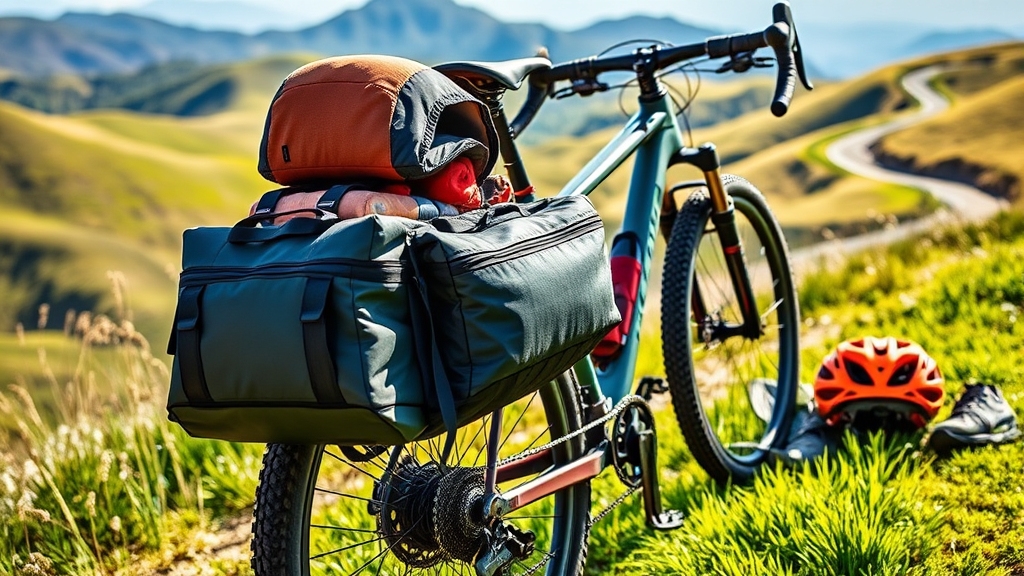
Packing the right gear and clothing is essential for a successful bikepacking adventure.
You’ll want to choose versatile, quick-drying clothing that maximizes your outfit combinations while minimizing space. Here’s a list of essential gear to pack:
- Two short sleeve shirts and two long sleeve shirts
- Three pairs of moisture-wicking bike shorts and jerseys
- Arm warmers and a waterproof jacket for varying weather
- Two pairs of socks and underwear, plus a bathing suit
- Lightweight sleepwear and multifunctional items
Utilize clever packing techniques, like rolling socks inside your shoes and using your helmet to store small clothes.
Packing Methodology
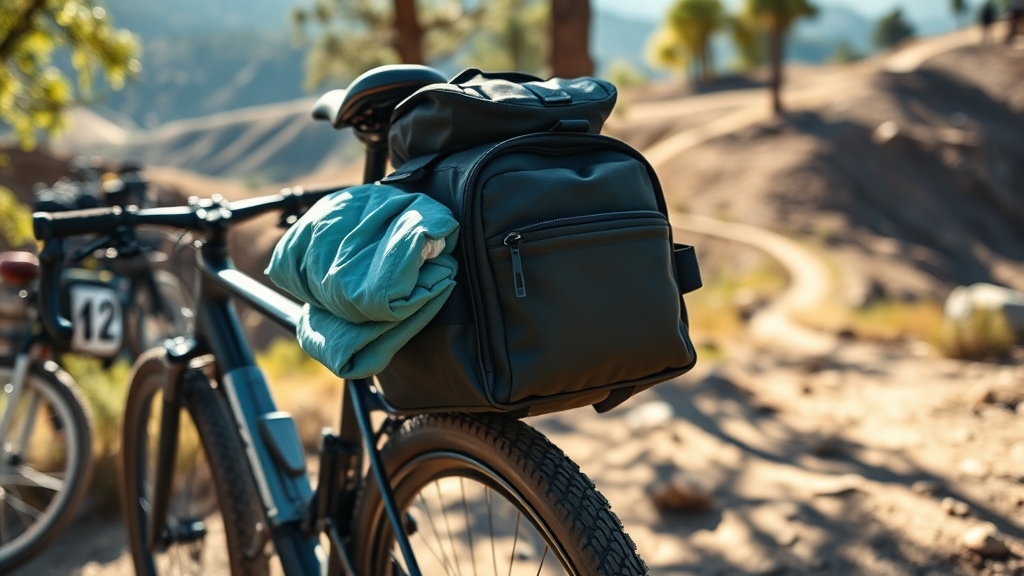
With your gear and clothing sorted, it’s time to focus on how to pack everything efficiently.
Start by packing socks inside your shoes to maximize space and stay organized. Use your helmet to cushion small bike clothes, which keeps them safe and tidy. Fold off-bike clothes neatly beside the helmet for ideal organization.
Maximize packing efficiency by stashing socks in shoes and using your helmet to cushion bike clothes.
To avoid extra weight, roll or stuff additional items into side spaces of your carry-on, leaving room for potential souvenirs. Use waterproof bags and ziplock baggies to protect electronics and warm layers from moisture.
Prioritize daily essentials in easily accessible spots, while burying non-essentials until needed. This packing methodology simplifies access during your bikepacking adventure, ensuring a smooth journey. Additionally, consider using waterproof materials to further safeguard your gear from unexpected weather changes.
Travel Attire and Daypack Essentials
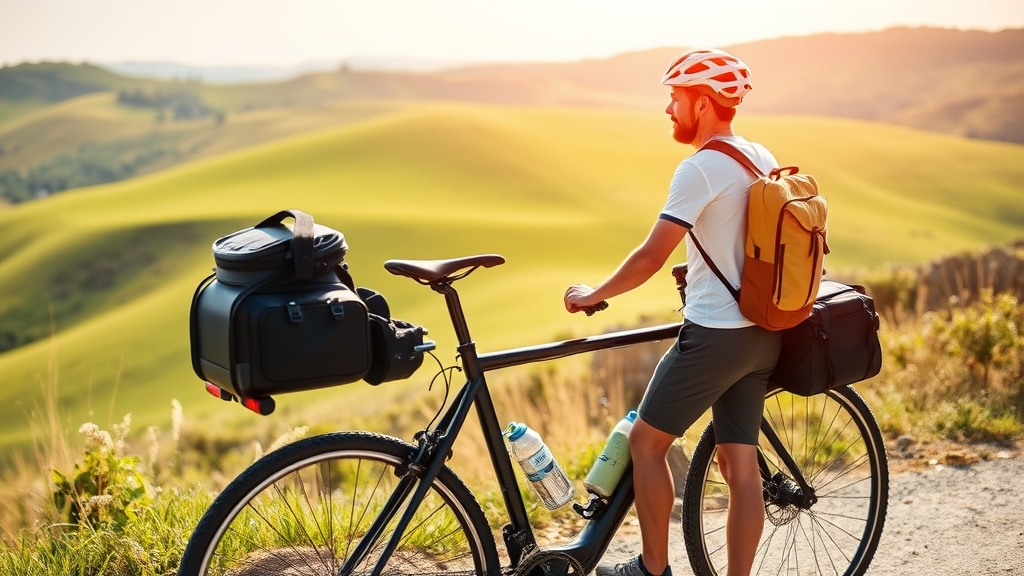
When you’re heading out on a bikepacking trip, your travel outfit plays a vital role in comfort and convenience.
You’ll want to pack a versatile daypack filled with essentials like snacks and hydration to keep you energized on the go.
Let’s explore how to choose the right attire and what to include in your daypack for a smooth journey.
Comfortable Travel Outfit
A comfortable travel outfit makes all the difference during your journey. Opt for yoga pants—they’re easy to wash and provide ample comfort.
Layer with a light jacket or sweater that has pockets for easy access to essentials, ensuring you stay warm during flights or layovers. Slip-on shoes are a must; they streamline security checks by making it easy to remove them quickly.
Here are some key components to take into account for your comfortable travel outfit:
- Yoga pants for flexibility and comfort
- Light jacket with pockets for convenience
- Versatile layering options (short and long sleeve shirts)
- Slip-on shoes for easy security access
- Accessories like a hat or scarf for added warmth
With these choices, you’ll travel in style and comfort!
Daypack Essentials Checklist
Packing a lightweight daypack is key to staying organized during your travels. Start your daypack essentials checklist with your ID or passport, cell phone, iPad, and chargers, ensuring these items are easily accessible.
Next, wear comfortable travel attire, like yoga pants and a light jacket with pockets for convenience. Slip-on shoes can help you breeze through airport security checks.
Organize your daypack so that daily essentials are in easy-to-reach locations, while non-essentials can be packed deeper in the bag. This setup makes it simple to grab what you need without rummaging around. Additionally, consider including financial considerations for your travel plans to ensure you are well-prepared for any unexpected expenses.
Snacks and Hydration Tips
To keep your energy up while bikepacking, it’s vital to choose snacks that are both nutritious and easy to carry. Opt for protein-rich, energy-dense options to fuel your adventure.
Use lightweight, resealable bags to keep your snacks organized and waste-free. Here’s a quick list of ideal snacks:
- Nuts (almonds, walnuts, or cashews)
- Trail mix (with dried fruit and seeds)
- Energy bars (high in protein)
- Jerky (beef or plant-based)
- Nut butter packets (for a quick boost)
Incorporating chia seeds into your trail mix or energy bars can offer an extra boost of omega-3 fatty acids and fiber.
For hydration, a collapsible water bottle or hydration bladder that holds at least two liters is essential.
Don’t forget electrolyte tablets to replenish lost minerals, especially in warmer weather. Keep quick-access snacks in your daypack for easy refueling on the go!
Electronics and Charging Solutions
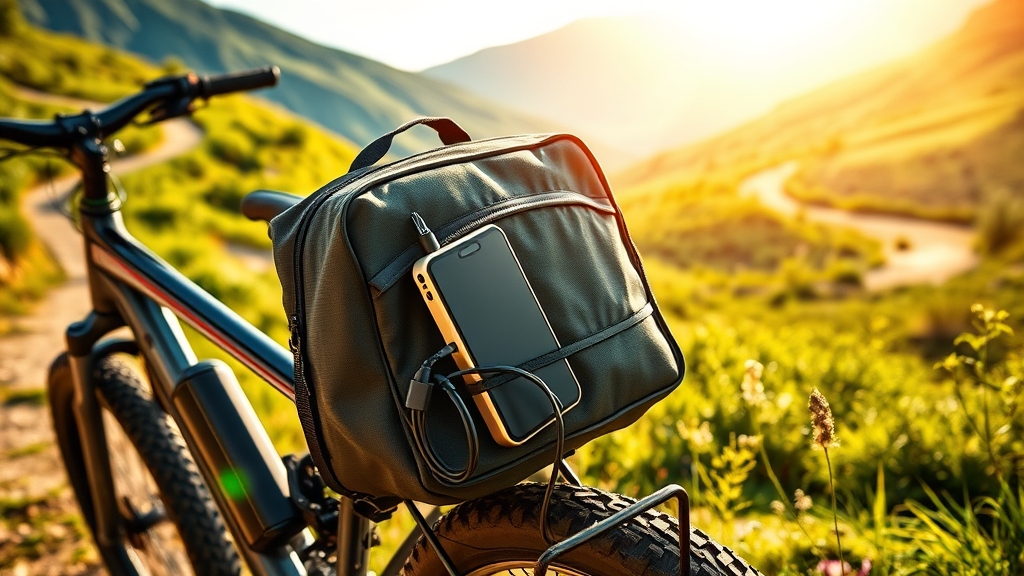
How can you stay connected while bikepacking without sacrificing space in your carry-on bag? Start by packing a portable USB power bank; it’s essential for recharging your electronics multiple times on the go.
Look for models that can fully charge your smartphone several times. To conserve battery life, keep your phone in airplane mode—this can extend usage by up to 30%.
Consider on-the-go charging solutions like dynamo hubs, which generate power while you cycle, or lightweight solar chargers that can recharge devices in direct sunlight in just a few hours.
Finally, don’t forget a satellite messaging device for reliable emergency communication in remote areas where cellular coverage might fail.
Stay powered up and connected!
Safety Considerations for Bikepacking
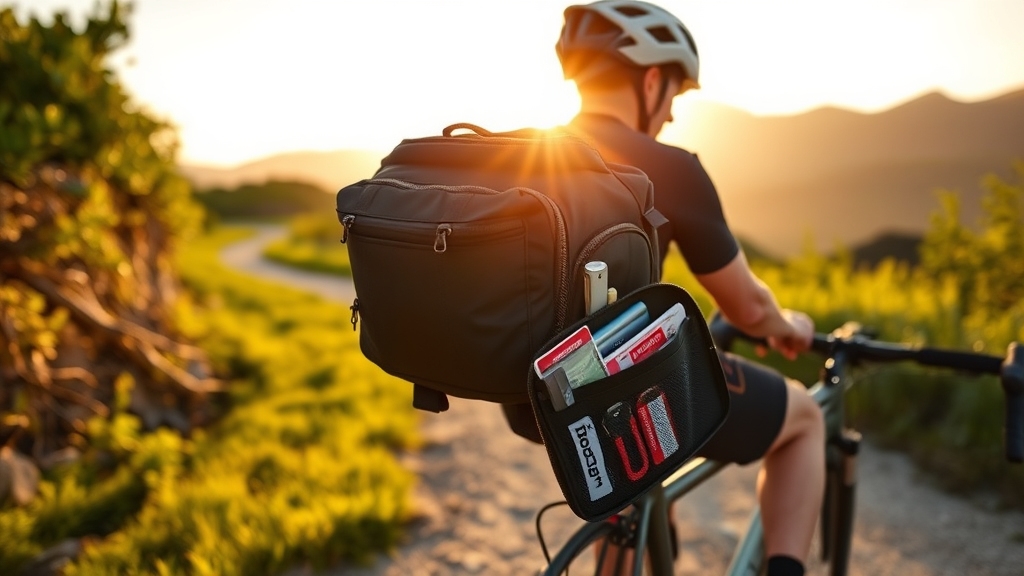
When you’re bikepacking, safety should always be a top priority.
Make certain your gear is secure and consider carrying emergency communication tools, so you can stay connected in case of trouble.
Understanding packing safety regulations also helps guarantee you’re prepared for any situation that might arise on the trail.
Gear Security Measures
What steps can you take to guarantee your gear stays secure while bikepacking? Implementing effective gear security measures is essential for a smooth adventure.
Start by securing all gear and attachments to your bike with tethers to prevent loss or damage on rough trails. Regularly check buckles and straps to confirm everything’s fastened tight.
Here are some additional tips to enhance your gear security:
- Use lightweight filters for safe drinking water.
- Fill gaps in your bike box with clothes or packing bags to minimize movement.
- Monitor the weight and dimensions of your packed gear to avoid airline complications.
- Consider using lockable bags to deter theft.
- Always keep essentials within reach for quick access.
- Understanding the role of contrast ratio in gear selection can help you choose items that are both lightweight and durable.
With these measures, you’ll bikepack with confidence!
Emergency Communication Tools
While bikepacking, staying connected can be just as essential as enjoying the ride itself. Emergency communication tools, like satellite messaging devices such as the Garmin inReach, allow you to send texts and signal for help even in remote areas without cell service.
To keep your devices charged, pack a portable power bank so you can recharge multiple times throughout your trip. Keep your smartphone in airplane mode to conserve battery life, but still use it for navigation when needed.
Utilize GPS tracking apps and emergency contact features to let friends or family monitor your route and receive alerts if you’re in distress. Regularly check gear attachment and secure communication devices with tethers to guarantee access during emergencies.
Packing Safety Regulations
Packing safely for your bikepacking adventure is essential, especially when traveling by air.
To adhere to packing safety regulations, keep these tips in mind:
- Check the airline’s specific carry-on size and weight limits to avoid extra fees.
- Secure all items in your bag to prevent movement that could damage delicate bike parts and electronics.
- Avoid packing prohibited items like sharp tools or oversized liquids for smoother security checks.
- Use protective materials such as bubble wrap for fragile components, ensuring compliance with safety measures.
- Maintain a checklist of packed items to confirm everything is secured and ready for your flight.
Final Packing Steps and Security

Before sealing your carry-on bag, take a moment to verify everything is secure and compliant with airline regulations.
Start with the final packing steps: fill any gaps with soft items like clothes or bike packing bags to cushion fragile gear.
Fill any gaps in your bag with soft items, like clothes, to protect your fragile gear during travel.
Weigh your packed bag to guarantee it meets airline limits, typically around 15-22 pounds for carry-ons.
Secure all items inside using bubble wrap or soft clothing to protect delicate parts.
Don’t forget to double-check for any missing gear—make sure everything essential is packed.
Finally, conduct a thorough inspection for compliance, ensuring no prohibited items are present. Additionally, consider including a portable camping toilet for convenience during your trip if needed.
Once you’re confident everything’s tightly packed and secure, you’re ready to hit the road with peace of mind!
Frequently Asked Questions
Is It Better to Bikepack With or Without a Backpack?
When you’re deciding whether to bikepack with or without a backpack, consider your comfort and efficiency.
Without a backpack, you’ll enjoy better weight distribution and stability, reducing strain on your back. Plus, it helps prevent overheating, especially in warm weather.
By using a well-organized carry-on bag instead, you’ll have easy access to essentials and can travel more aerodynamically.
Ultimately, going without a backpack could lead to a more enjoyable ride.
How to Pack a Bicycle for a Flight?
Packing a bicycle for a flight might seem intimidating, but it doesn’t have to be stressful!
Start by dismantling your bike: remove the pedals and handlebars, and keep the bolts organized. Use a sturdy bike bag or cable box for protection.
Wrap fragile parts in bubble wrap, and fill gaps with clothes to prevent shifting.
Finally, double-check everything’s secure, and make sure your packed bike meets airline regulations before heading to the airport.
How Many Miles a Day Is Bikepacking?
When you’re bikepacking, the miles you cover each day can vary widely. Most bikepackers aim for 30 to 60 miles, but experienced riders might push that up to 100 on flat terrain.
If you’re new or prefer a slower pace, 20 to 30 miles can feel manageable.
Keep in mind that factors like elevation, trail conditions, and your gear’s weight will all influence how far you can realistically ride each day.
Enjoy the journey!
How Do You Carry a Tote Bag While Cycling?
When you’re cycling with a tote bag, choose a crossbody style or one with a shoulder strap to keep the weight balanced.
Make sure it’s made of durable, weather-resistant material to protect your items.
Use a secure closure like a zipper to prevent spills.
You can attach the bag to your bike frame or handlebars with clips to keep your hands free.
Finally, pack efficiently to maximize space and minimize shifting.
Conclusion
Now that you’re equipped with the know-how, imagine yourself gliding down a sun-dappled trail, the wind teasing your hair, and your carry-on bag snugly perched on your bike. With every pedal stroke, you blend freedom and adventure, proving that less truly is more. So, pack light, ride far, and let the open road become your canvas. Embrace the journey ahead; it’s not just about the destination but the stories you’ll gather along the way.









